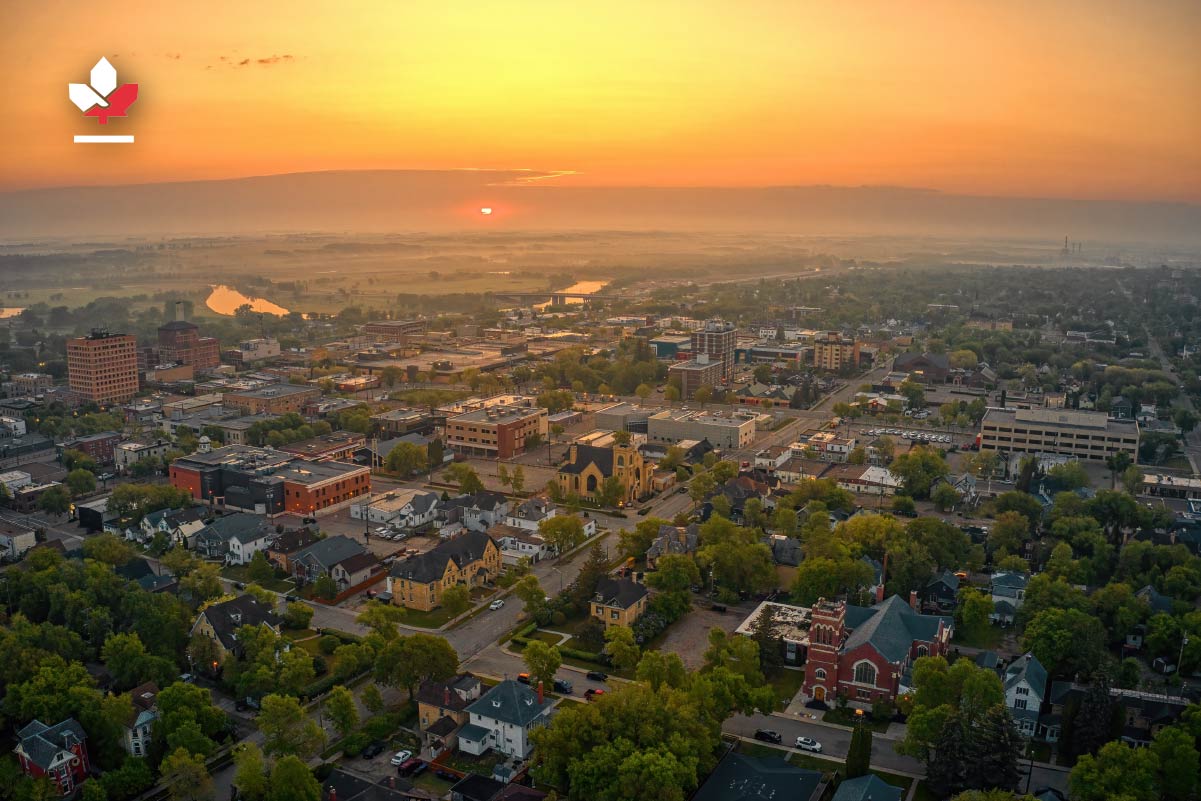Top 3 Towns in Canada's Rural and Northern Immigration Pilot
July 1, 2024
|
Canada's Rural and Northern Immigration Pilot (RNIP) presents an inviting pathway if you are a foreign skilled worker seeking to settle in lesser-known yet promising Canadian towns. Among the standout destinations are Sault Ste. Marie, Thunder Bay, and Brandon. Each offers a unique blend of career opportunities and community-focused living.
Ready to learn which of the top 3 towns in Canada's RNIP? Then take a look at the guide to the promising opportunities and welcoming communities of Sault Ste. Marie, Thunder Bay, and Brandon, Manitoba in Canada's RNIP.
What Are the Top 3 Towns in Canada's Rural and Northern Immigration Pilot?

Canada's RNIP is a strategic program to attract skilled immigrants to smaller communities facing labor shortages and population decline. Here are the top three towns in Canada's RNIP.
Thunder Bay, Ontario
Thunder Bay, Ontario, sits proudly on the northwestern tip of Lake Superior. With deep significance in indigenous history, the Ojibwe people called it Shebandowan, which means "place at the head of the lake." European fur traders arrived in the 17th century, and the city's development revolved around the fur trade and, later, resource extraction. Today, Thunder Bay remains a vital transportation hub, with its port handling a significant portion of Canada's grain exports.
Thunder Bay's natural environment is crucial to its identity. Lakehead University, a leading research institution, houses the Centre for Freshwater Resources and Environmental Research. This center tackles critical issues like climate change and water quality, contributing significantly to our understanding of the boreal ecosystem. Thunder Bay Field Station provides researchers with a unique platform to study forestry, wildlife ecology, and sustainable resource management practices
Indigenous influences deeply interlink into Thunder Bay's culture. The Fort William Historical Park, a UNESCO World Heritage Site, meticulously recreates a fur trading post, offering a glimpse into the historical relationship between Indigenous peoples and European traders. The vibrant Anishinabek Art Gallery showcases the artistic expressions of First Nations, Inuit, and Métis communities. Beyond its Indigenous heritage, Thunder Bay boasts a thriving arts scene. The Thunder Bay Symphony Orchestra and the Magnus Theatre provide residents with a rich tapestry of artistic experiences.
Brandon, Manitoba
Situated in the fertile Assiniboine Valley, Brandon, Manitoba, proudly wears the title "Wheat City." Settled in the mid-19th century, Brandon initially served as a waypoint for fur traders but quickly blossomed into an agricultural powerhouse. The Canadian Pacific Railway's arrival in 1881 cemented its position as a crucial transportation hub for grain exports.
Brandon's agricultural prowess extends beyond its vast fields. Assiniboine Community College, a leader in applied learning, offers numerous agriculture-focused programs that equip students with the skills to excel in this vital sector. Furthermore, Brandon University houses the George Brock Centre for Studies in Rural Planning and Development, which researches sustainable agriculture, food security, and rural community development. These initiatives highlight Brandon's commitment to agricultural innovation and ensuring a secure food supply.
Brandon's rich history is evident in its heritage buildings. The Brandon Wheat King Centre, once a CPR station, now serves as a multi-purpose entertainment venue, while the Brandon Post Office Museum showcases the city's postal history. Brandonites, known for their warm hospitality, celebrate their heritage through events like the Brandon Folk Festival and the Manitoba Summer Fair, the largest agricultural fair in Western Canada.
Sault Ste. Marie, Ontario
Sault Ste. Marie, Ontario, nicknamed "The Soo," sits on the St. Marys River, connecting Lakes Superior and Huron. French missionaries named the city in the 17th century, referencing the rapids on the river. The discovery of iron ore deposits in the 1800s transformed The Soo into a major industrial center, with steel production becoming its cornerstone. Today, the city remains a vital center for manufacturing and transportation.
Sault Ste. Marie fosters a strong research environment, particularly within the steel industry. The Algoma University Steel Research Group collaborates with industry partners to develop innovative production methods and enhance the sustainability of steel production. Beyond steel, Sault College, a leader in career-focused education, offers programs in various fields, including healthcare and environmental technology, fostering a diverse research landscape.
The Soo boasts stunning natural beauty despite its industrial heart. Visitors can explore the cascading Agawa Canyon or hike the scenic trails of Pukaskwa National Park. Indigenous heritage is also deeply embedded in the city's identity. The Sault Ste. Marie Museum houses a significant collection of Indigenous artifacts, while Shingwauk Residential School.
What Are the Benefits of Living in the Top 3 Canada RNIP Communities?

The RNIP offers a compelling path to many benefits for newcomers to Canada. Here is a closer look at the advantages of settling in one of the top RNIP communities.
Fast-Tracked Permanent Residency
RNIP communities prioritize filling labor shortages with skilled immigrants seeking Canadian permanent residency. This translates to a streamlined and expedited path to Canadian permanent residency compared to traditional immigration routes. The community is crucial in recommending your application, significantly reducing IRCC processing times.
Enhanced Support Services
RNIP communities understand the challenges of settling in a new environment. Many offer comprehensive support services, including language training, job search assistance, and help with finding housing. This support system fosters a smoother transition and integration into your new home.
Learn more about the top settlement services for newcomers in Canada.
Affordability
Compared to larger cities, the cost of living in many RNIP communities is significantly lower. Housing, transportation, and other essential expenses are more affordable, allowing you to stretch your budget further and enjoy a higher quality of life.
Learn more about the affordable cost of living in Canada.
Entrepreneurial Opportunities
Some RNIP communities recognize the potential of newcomers with entrepreneurial skills. They may offer programs or resources to support business startups, fostering economic growth and creating new jobs within the community.
Learn about the most successful immigrant businesses in Canada.
Family-Friendly Atmosphere
Many RNIP communities boast a strong sense of community and a slower pace of life. This can particularly appeal to families seeking a safe and nurturing environment to raise their children.
Learn more about what makes Canada one of the most family-friendly countries in Canada.
Outdoor Activities
RNIP communities are often located in regions with stunning natural landscapes. This provides ample opportunities for outdoor activities like:
- Hiking,
- Fishing,
- Camping and
- Exploring nature,and
- Creating a healthy and active lifestyle for the whole family.
How Can I Move to These Top 3 Towns Using Canada's RNIP?

To move to one of the top three towns in Canada's RNIP, follow these steps.
Step 1: Ensure you Meet the Federal Eligibility Criteria
First, ensure you meet the federal eligibility criteria, which include having a recommendation from one of the designated RNIP communities, at least one year of continuous work experience in the past three years, a genuine job offer in the community, and sufficient funds to settle.
Step 2: Find an Eligible Job Offer in One of the Top Three RNIP Towns?
Next, find an eligible job in your field of work in one of the RNIP communities, such as Thunder Bay, Brandon, or Sault Ste. Marie. These towns have specific in-demand occupations they are looking to fill, including roles like a:
- Registered nurse,
- Pilot,
- Chef, and
- Truck driver.
Learn more about how to land a job in Canada.
Step 3: Submit an Application For a Community Recommendation
Once you have a job offer, apply for a community recommendation. The community will assess your application based on criteria like your intention to live in the area, alignment with their economic needs, work experience, and connections to the community. If you receive a recommendation, you can submit your RNIP application to IRCC.
Learn more about how to settle in Rural Canada with the RNIP.
Rural Community Immigration Pilot
The Rural Community Immigration Pilot (RCIP) will launch in the fall of 2024 to address labor shortages in rural communities like Thunder Bay, Ontario; Brandon, Manitoba; and Sault Ste. Marie, Ontario. This initiative offers pathways to permanent residence for newcomers who can fill critical job vacancies and are committed to long-term residency in these smaller towns. The program supports local businesses by providing access to skilled workers to sustain and grow community economies.
Francophone Community Immigration Pilot
Launching in the fall of 2024, the Francophone Community Immigration Pilot, which will also be launched, aims to increase the number of French-speaking newcomers settling in Francophone minority communities outside of Quebec, including Thunder Bay, Ontario; Brandon, Manitoba, and Sault Ste. Marie, Ontario. This initiative seeks to support the economic development of these communities while contributing to the restoration and growth of their demographic presence.
FAQs
What Are the Cultural Aspects to Consider When Moving to a Smaller Town?
Moving to a smaller town brings forth unique cultural considerations. Embrace local traditions and festivals to integrate seamlessly. Engaging with community events fosters strong relationships.
What Resources Can Help Me Find a Job in an RNIP Town?
Finding a job in an RNIP town is facilitated by several key resources. Use local job boards and networking events. Consulting with immigration services can provide invaluable career guidance.
How do I Choose the Right RNIP Town For Me?
Choosing the right RNIP town involves strategic decision-making. Consider factors like job opportunities, community vibe, and lifestyle preferences. Visiting prospective towns can provide firsthand insights.
